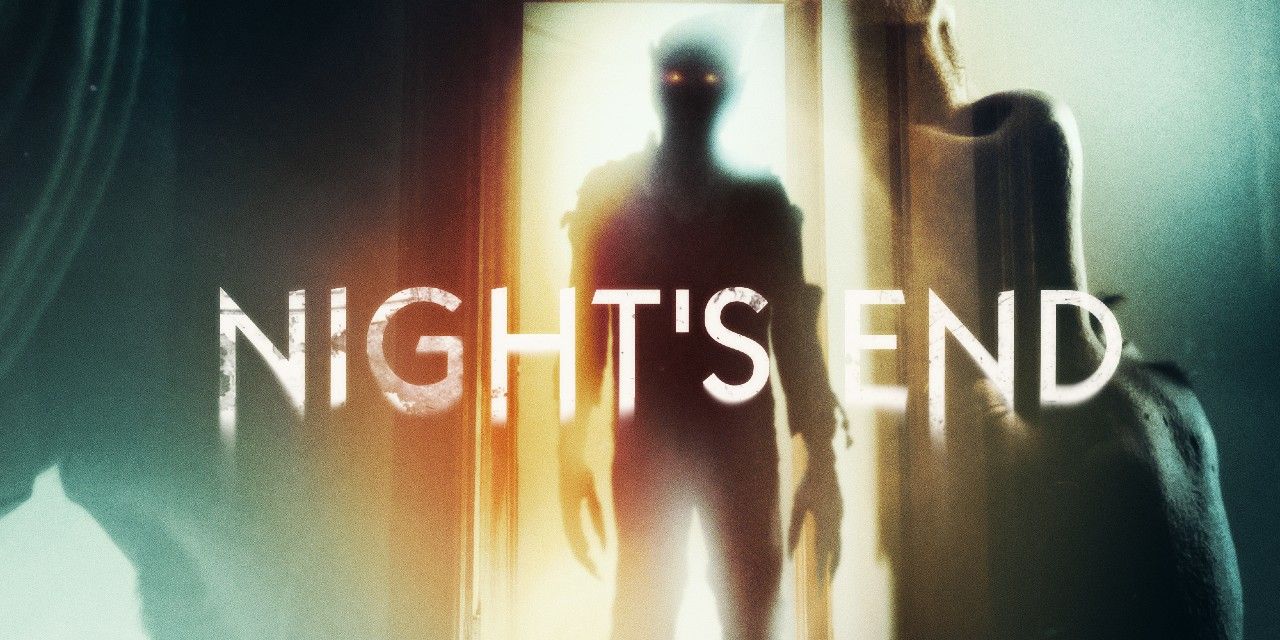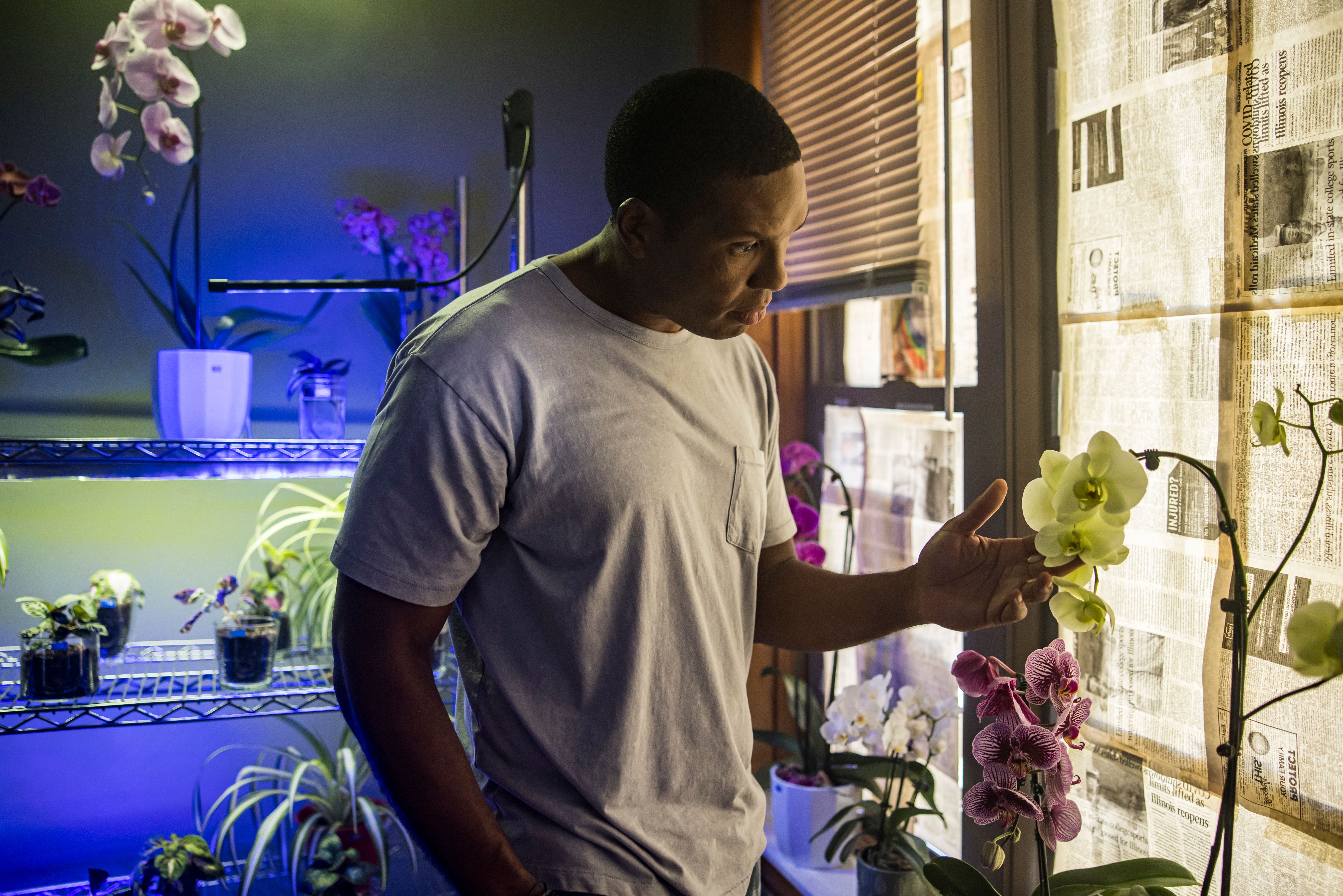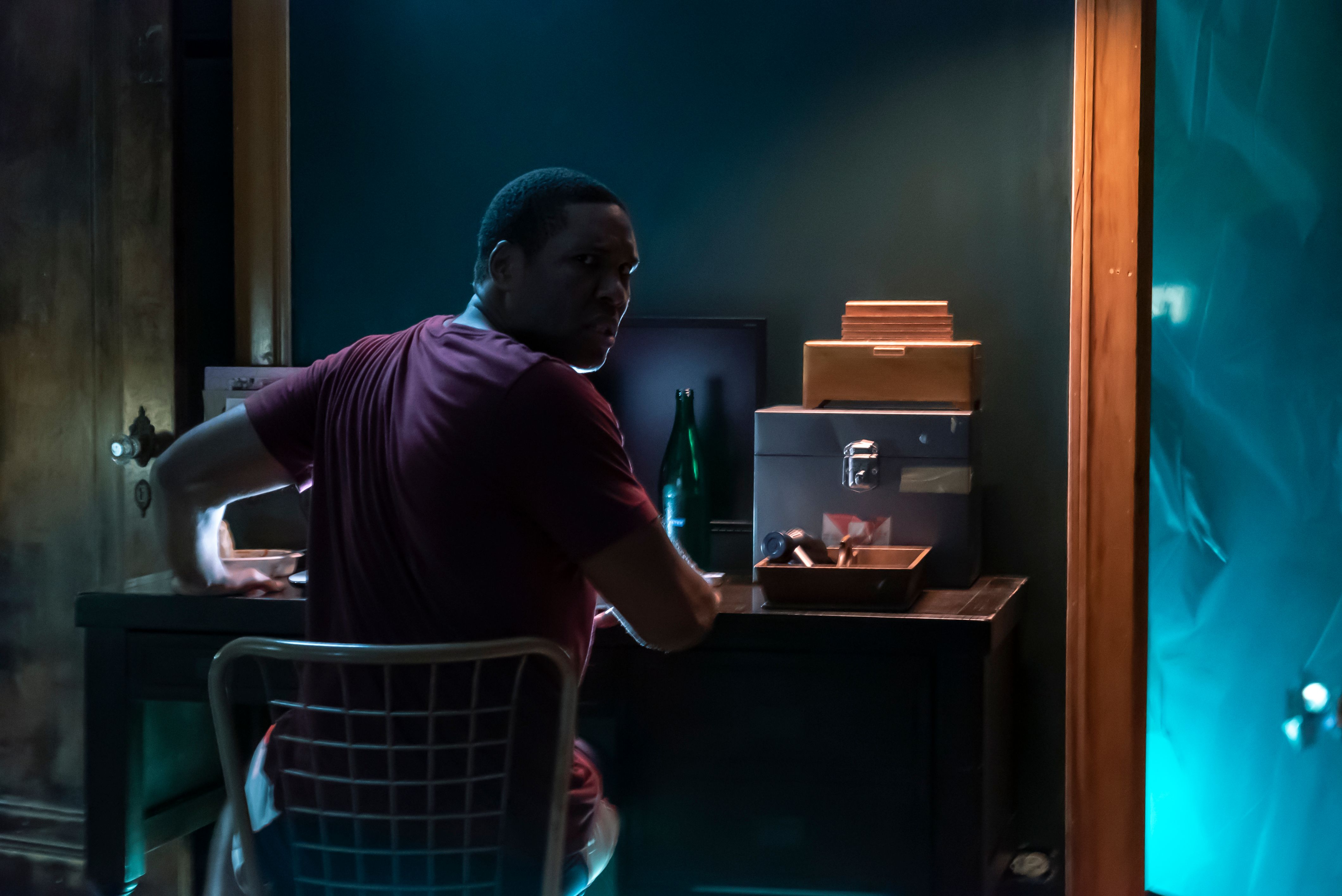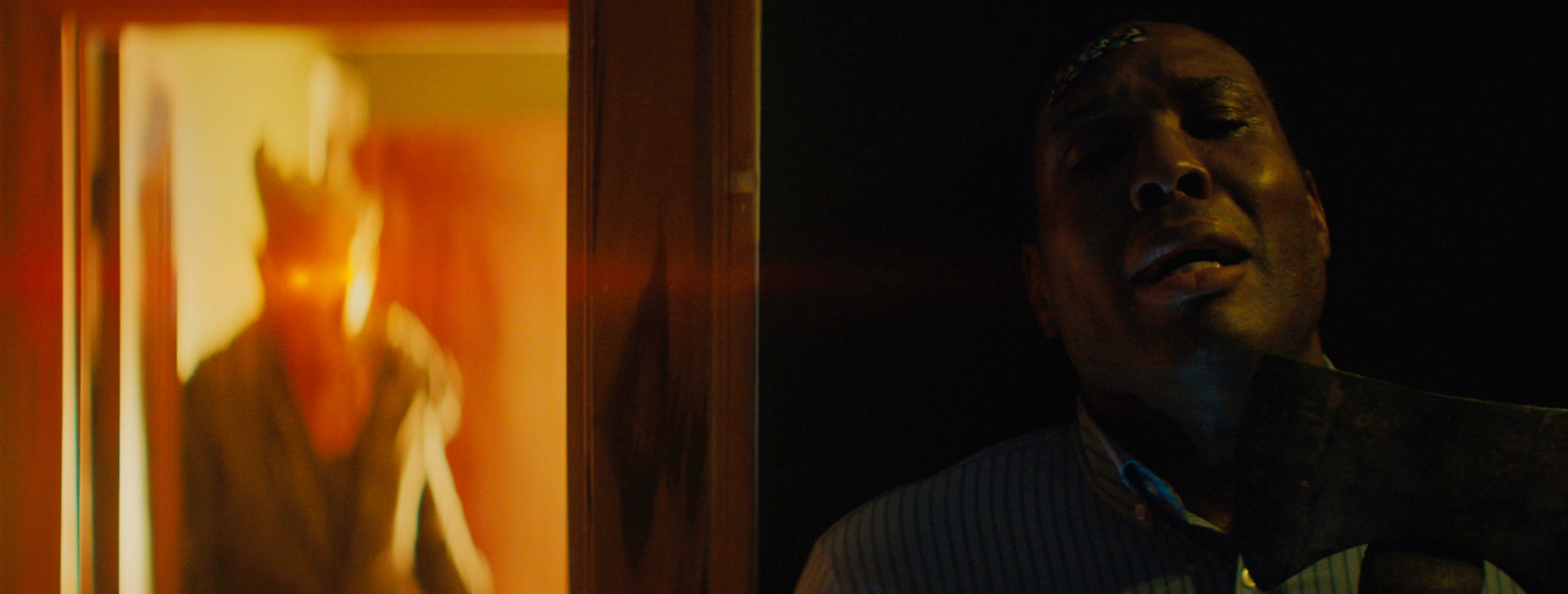The upcoming Shudder original film Night's End weaves a haunting and, at times, romping horror film about the powers of fear and isolation. Written and co-produced by Brett Neveu and directed by Jennifer Reeder (V/H/S/94, Knives and Skins), Night's End opens as a minimalistic ghost story setup. The horror film follows the anxious and agoraphobic Ken Barber looking to prove if there is or isn't a ghost in his new apartment. The closer Ken gets to uncovering the truth, the more sinister events unfold, pushing Ken to his mental limits.
During an exclusive interview with CBR, Night's End director Jennifer Reeder weighed in on how she approached filming a horror story about isolation during one of the most isolating times in recent memory. Reeder shared how she brought some of the screen-based horrors in the film to life and discussed how John Carpenter's work influenced the film's Big Bad.
CBR: There were a lot of Zoom-screen-like scenes in the film. When incorporating that into your directing, how did that affect your focus on certain shots? I imagine it's always tricky to film screens because of lighting and whatnot. What did you learn from that experience?
Jennifer Reeder: A couple of the first conversations around it, we had conversations about like, "Should we really shoot everybody but Ken on webcams? Should we just let people be at their house and shoot them like that?" But all of those options, in terms of directing, seemed like no fun at all.
Instead, we had one location and we shot everybody by themselves. All the people that Ken is talking to, we would shoot them over there day and a half or two days, and build out their background, and shoot them cinematically with a beautiful Alexa camera with anamorphic lenses. In post-production, we added a customized pixelated filter that made it so when we pop into the full-frame of them, it gives us that screen-life texture. When we were shooting, the hardest part was when we were shooting over Ken's shoulder onto his monitor -- which also was when you're shooting totally blank screens with just little guide marks, or, oftentimes, his script was on the laptop so he was able to cheat [laughs] -- and then we comped in those computers. We directed Geno Walker to not go in front of the screen because that's a difficult thing for VFX to composite. So, we had some limitations.
But I feel like there's good chemistry between those characters, even though, in reality, none of them were acting with each other. The only two people who were acting with each other were Mike Shannon and Kate Arrington. They were actually in the same frame, but everybody else was acting solo. Part of that was the COVID of it. We were still under much stricter COVID guidelines, and we just didn't want to risk, mostly actors, who would come in unmasked to do their parts. We had a very tight window, right before they went back into their TV show or went back into another film. So the scope of it was like accommodating actors' schedules, really being mindful that we didn't want to be responsible for making an actor sick and then making their whole cast of the next project sick. I think the hardest part is directing an actor with a mask on because communication with masks has gotten weird. We all thought it was hard to read the nuance of a text message, and now it's harder to read the nuance of just someone's brow line. Like, "Are you smiling under that mask? I cannot tell."
I don't want this to feel like a COVID film. There are probably a lot of films that were made during this year and some of them seem like a bigger scope, and some of them not. We were just shooting in a big city like Chicago during that summer when there were still surges and were trying to be really mindful. I'm glad we were able to make it anything at all. But I would hope that in five years from now, 10 years from now, people watch this film and their takeaway isn't just this was a film that was made during COVID. It's really about the perils of isolation.
I don't think it's a film that only lives in the pandemic but when making a film about isolation -- while living in a pandemic -- the processing of that is going to make its way on-screen in one way or another. There's an incredible eeriness to the film in that way. It does have this time capsule effect. For me, some of the quieter moments scared me more like, "Oh god, Ken, please don't fall off that upside-down chair!"
Right, right, [laughs].
What were some things that you worked with Geno Walker on to get across that feeling of isolation on-camera?
The funny part is that when we cast Geno, last summer, he was very much a single man living by himself with a lot of plants and spending a lot of time by himself. He and I talked through like, "What do you do when you're alone in your apartment?" We knew we didn't want him to be a gamer. We couldn't just have a sequence where he sat and watched a movie. It didn't make sense for us to have a long sequence of him reading a book. We still were making something that had to have something more plot-driven to hang on to, so we figured out how does Ken spend his day.
In Brett's script, he was already an amateur YouTuber. He was trying to dip his toe into that world very unsuccessfully. So we knew there would be some level of those self-tape moments involved. But then I worked with Brett and Geno to think through the inclusion of the orchid room or the taxidermy or his stretching on the inversion table. But there was something about that I just really liked. Before we even got into that space, I was in my head really thinking about just exactly the shots that are in there -- this empty, in-transition room and this very monumental guy, very tall and broad-shouldered, laying on this inversion table upside down. And that being this kind of a -- maybe too on the nose -- metaphor for how Ken's life is upside-down. Working that stuff out with him was really interesting. Geno had a lot of dialogue. Brett is a playwright, and if you work with playwrights you realize they write a lot of dialogue. When we were getting ready for shooting, Geno and I thinned out some of the dialogue that felt like was not quite what he thought Ken would say or interact with his best friend Terry and his ex-wife. Since he's in every shot, I wanted Geno to really feel like he owned Ken's world.
I wanted to talk about that glitchy effect that was added in post-production. I really loved it as a viewer because it made me double-check each shot to see if I missed something, which kept me engaged. What was your intention for that visual effect?
In retrospect, I wish that some of that glitchy stuff was a little more nuanced.
But that is absolutely a whole layer that I knew, and our Director of Photography Christopher Rejano, and our Editor Mike Olenick, all three of us, wanted. We thought there's got to be these little glitchy moments. First of all, I think that, that these digital disruptions can be really beautiful -- just from a pattern standpoint when pixels become those little digital squares. You realize that, yes, you're talking to somebody live, but it's totally mediated through this weird electronic signal that at any moment can completely break apart. There's also something that I'm sure we've all experienced during these two years of talking to somebody through video conferencing. They freeze at this very strange moment or their audio warbles at a very strange moment. Sometimes, it's oddly serendipitous when they freeze. Or then they unfreeze and then nobody else freezes. You're relying on the machine to work, but the machine itself is destined to not work.
I think that the glitches also were about the idea that the signal itself of the actual film is haunted. Maybe that sounds kind of goofy, but I really like that. Some weird stuff was happening on set like the camera would shut off on its own, which is not something that a camera normally does. Mike had all sorts of bizarre things happen during the editing. We were totally convinced that we had certainly conjured some actual paranormal activity while making this film [laughs]. But, knowing that this project was going to eventually land on Shudder and that a lot of people would be watching it through a screen, I was like, "Oh, I want to add some glitches that happen internally to those monitors, and then also add some glitches that are happening to the film itself, so that someone might think like, 'I think my, my own signal is glitching.'" It's a little trick. A little of there may or may not be a ghost in the machine.
There's a jump-scare moment I won't spoil with a hand, but it made me and then my dog jump right off the bed.
Oh, that's good to know! I was really excited to try and make those jumpscares work. It's not something I've done in previous films.
On that note, what do you think makes a good jump-scare?
I think sometimes it's leading an audience to expect it, and then just waiting a bit too long. So that they're like, "Oh, it was just a trick," and then it actually comes. So I feel like for one of them, where there's the hand on in the door -- I will just say that -- we really tried to build that up. So there's this expectation but then we wait just long enough so that you might think like, "Oh, that was just a lead-up to nothing," and then something that happens. There's another when Ken's watching the Dark Corners show, there's another little blip. There are little startling things that happen here. Some of it is letting an audience expect it and then giving it to them anyway because there's still something about anticipating a jumpscare, which is part of the pleasure of a jumpscare --
-- like candy.
Right, exactly. Those are not easy. It's not a given. You can't just have somebody pop out of a closet -- nobody pops out of a closet and this one, so I didn't spoil anything. There's nuance to timing, what the scare is, and what the content of the scare is. I didn't want to do too many because then you just increase your chances of having one of them fail. There's nothing I would have wanted to do less than make a failed jumpscare.
What were some rules that you had when figuring out how you want spirits to appear and work on-screen? It's easy to say, "A ghost appears," but there are so many ways that can go!
That's a really good question. A lot of Night's End's ghostly shapes appear behind Ken where the audience can see it but Ken cannot. We really tried to keep track of the idea that there's one ghost in the house until another one gets conjured -- I'll leave it at that.
There were times when it felt like the shape of the ghost made it seem like it wasn't the same ghost. So, for instance, I was like, "That clearly is the PA, a guy walking through there. We can't use that." That would just become confusing. But I think the specific kind of spirit logic that we dealt with is, "How does the final monster manifest? Who manifests it?" And, "How are these things possible?" There's nothing funnier than a bunch of adults talking about something like that on-set before you're shooting and arguing through it. A lot of the ghost logic was also about when Ken would see the ghost, and trying to keep that a little bit more mysterious. For the most part, he sees it behind him on his own screen. There was something that felt really fruitful about the audience being able to see it when Ken can't see it. Those are the real interesting questions to figure out.
Is there anything else about Night's End that you'd like people to ask more about or that you'd love to bring up that we didn't cover?
I think it's not so much a question that I haven't gotten yet, but a takeaway that I want for audiences is to feel that this is also living in a trajectory of some really great vintage horror. I don't think of Night's End as being completely campy, but there are camp elements to it in a kind of John Carpenter's Prince of Darkness way. The film's composer and I talked a lot about Carpenter's scores and tried to do a little ode to Carpenter in the score. So, it's got a sense of humor. It's got some sense of campiness. It's not taking itself so seriously. But I really hope people enjoy it, and are entertained by it, but also are able to have a meaningful conversation about video conferencing communication and isolation and the perils of alone time.
Step into Ken Barber's haunting apartment in Night's End, debuting on Shudder March 31.




